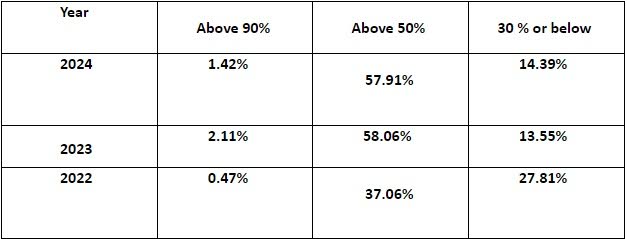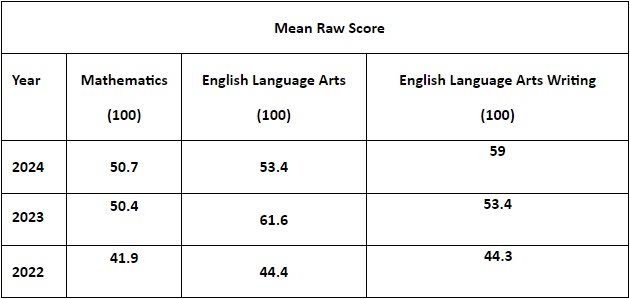What the SEA results say

ALTHOUGH the Ministry of Education has pronounced this year’s Secondary Entrance Assessment (SEA) results as “a generally encouraging trend with regard to student performance,” experts are saying they show a long-term problem that is not being adequately addressed.
In a release on June 28, the ministry gave an analysis of the results saying the country was experiencing a “steady and stable recovery” from the affects of the pandemic. This after students returned to the physical classroom in April 2022 after two years of online learning because of covid19 restrictions.
It said, out of 100, the average mathematics score in 2024 was 50.7, compared with 50.4 in 2023 and 41.9 in 2022. The average English language arts writing score was 59 in 2024 while it was 53.4 in 2023 and 44.3 in 2022. And the average 2024 English language arts score was 53.4 compared with 61.6 in 2023 and 44.4 in 2022.
Of the 18,177 students who wrote the exam this year, of which 9,127 were male and 9,050 were female, 14.39 per cent scored 30 and below. This compared to 13.55 per cent in 2023 and 27.81 per cent in 2022.
The percentage of those who scored 50 per cent and above was 57.91, 58.06 per cent and 37.06 per cent in 2024, 2023 and 2022 respectively. And the percentage scoring 90 per cent and above was 1.42 per cent, 2.11 per cent and 0.47 per cent in 2024, 2023 and 2022 respectively.
It added that the ministry was hosting a Remedial Education Programme in 80 primary schools of focus, which included the assignment of dedicated school social workers, guidance officers, special education officers and learning support assistants, and included initiatives like the After School Support Education Programme.
“In 50 per cent of the 80 primary schools of focus, there has been an increase in the average weighted score of the students. Also, in 45 per cent of those schools, there was a decline in the percentage of students scoring 30 per cent and lower in SEA. This adds credence to the efforts of the Remedial Education Programme of the MoE, which has been approved to continue in both primary and secondary schools of focus until 2025/26.”
In addition to congratulating all the students who wrote the SEA exam, it reminded that the Secondary Vacation Revision Programme for students entering Form 1 in September, would take place at 21 centres across Trinidad starting on July 15.
Tabaquite MP and United National Congress shadow education minister Anita Haynes Alleyne said the data did not indicate any real statistical improvement in performance and data-based targeted interventions were essential to the path forward.

She said while the ministry was saying the results were “not the worst,” it was also “not good” that 42.09 per cent of the students got under 50 per cent and, therefore, were not at a level of competency to handle a secondary school curriculum. Far less for the 14.39 per cent that got 30 per cent and below.
“It is not enough to say that student performance in 2024 builds on improvements seen in 2023 when the context of last year’s performance improvement was directly related to the covid19 impacted results of 2022.
“We must also consider the matter of school placement. There have been instances in the past where students who require remedial education as they transition into secondary school are disproportionately placed. In the absence of resources at these institutions, teachers face a serious challenge to keep students engaged.
“We know these students are often susceptible to higher absenteeism and drop-out rates as well as instances of school violence. It is therefore critical that the Ministry of Education (MoE) ensures these schools are properly staffed and supported with social workers and counsellors.”
Haynes Alleyne said the Vacation Revision Programme had been under subscribed for several years and hoped more people accessed the provision. But that meant there were still many going into secondary school unprepared.
She said she had gotten reports that certain schools got a greater share of the students who scored below 50 per cent on the exam. Yet those schools were not given the additional resources, including student support services and social interventions, to deal with that additional concern.
In addition, she said, primary schools needed more or earlier intervention.
“The ministry highlighted that they saw better results in the 80 primary schools of focus in the Remedial Education Programme. But, given the results weren’t better overall, you need to expand the number of target schools and also focus, not on standard five alone, but on standards three and four because by the time you get to standard five you’re either prepared or you’re not.
She suggested if the ministry’s resources were not too limited, the programme should start preparing students for national tests from standard one. She said such preventative measures would require fewer students to do remedial work at the form one level.
'Problem of underachievement'
Recalling the average SEA scores over the years, retired lecturer at the UWI School of Education Dr Samuel Lochan said TT had a “long-standing problem of underachievement” and the trend continued this year.
He said, according to his records, in math, the average scores for 2009 to 2020 were 55.7, 55.3, 57.8, 56.2, 56.1, 54.6, 53.5, 54.7, 54.3, 55.3, 52.4 and 51.27 per cent respectively. In English language they were 57.3, 56.2, 54.7, 54.5, 55.6, 57.8, 57.8, 55.1, 59.7, 58.1, 52.7 and 57.6 per cent. And in English language writing they were 53.6, 50.7, 48.2, 53.9, 50.3, 52.9, 53.5, 53.3, 52.3, 45.7, 40.79 and 48.6 per cent.
“The ministry is claiming, and rightly so if you use 2022, which is a low year because it was right after covid, the scores have bumped up. However, when we go back to 2009, the averages were a bit higher in math and English language.
“So in the present day we have simply continued the long-term trend of 50-something per cent of our students getting above the mean, which means 40-something per cent of students are falling below the mean every year.
“And now 14.39 per cent got a score of 30 per cent and bellow. That is 2,615 students! We have a problem! And it’s a problem we have not been able to solve.”
He also noted that every year people called for the end of the SEA exam but no one had a better solution. He said the exam had become high-stakes, competitive, and it forced teachers to move at a speed that was not good for the development of all the children in primary schools.
He recalled the government attempted school-based assessments to bolster SEA scores but that did not last as they too turned into high-stakes testing. So another way to determine placement in secondary schools was something that had to be worked on carefully.
Lochan said before SEA could be removed, there needed to be several secondary schools in each school zone that were up to acceptable teaching standards and inspired confidence in parents. And at the primary school level it was necessary to improve the quality of teachers, the principal leadership and the resourcing of the schools.

He said there needed to be good overall management of teaching and learning, good supervision by principals and the teachers had to be trained and prepared to deal with the children’s various issues.
He added that the remedial programme was an emergency system but there needed a continuous system for assessment of students and interventions. He said the ministry should not wait until SEA results to provide interventions like the Vacation Revision Programme as teachers should know the capabilities of a child after end-of-term exams from standard one.
He said the 80 schools in the remedial programme had difficulties peculiar to each of the schools. Some schools and their students did not have good support from parents, the children had no supervision at home, some children went hungry, some had learning disabilities, some communities made life difficult for them and there were other issues.
As a result, the programme had to be managed on a school by school basis.
“There's a clear problem of how you manage teaching and learning, how to train and equip teachers, principals and schools? The question becomes, are the different schools geared to help a range of learners? Are we resourcing the schools and preparing them? Are we managing the quality of leadership from the ministry, from a supervisory level? What interventions you making on a continuous basis?
“And removing SEA, you would have to bring that whole sector up to par so what you have is most children coming out of primary school with levels of numeracy and literacy so they could go to secondary school.”
There has also been a steady decline in the number of students to write the SEA exam over the past few years. The numbers from 2020 to 2024 respectively were 19,344, 19,829, 19,198, 18,797 and 18,177.
Lochan said the decrease was a reflection of the declining birth rate in the country and the issue of the country’s ageing population was long-standing one.
“At the level of new entrants into the school system there is a decline. That is why the ministry, I think, was able to stop the double-shift system of junior and senior secondary schools. It means we had more spaces in the system.”

Comments
"What the SEA results say"